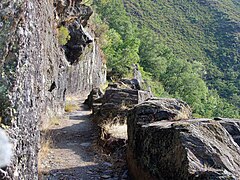|
拉斯梅德拉斯
拉斯梅德拉斯[1](西班牙語:Las Médulas)是位於西班牙萊昂省蓬費拉達近郊的一個地區,為人工惡地地形。這個地區在羅馬帝國時代曾是金礦的礦山,是古羅馬時期重要的,也是最大的露天金礦遺產。[2]這一地區的礦山和集落遺跡顯示出當時人們的生活情況。1997年,拉斯梅德拉斯被联合国教科文组织列入世界文化遺產[3]。 公元前25年,罗马皇帝奥古斯都征服了塔拉科西班牙地区。在罗马人征服之前,原住民已经从冲积层矿床中提取了部分黄金。罗马帝国在这里的大规模采金活动从公元1世纪下半叶开始。经过两个世纪的开采后,罗马帝国逐渐衰弱,这里随之被废弃。[3] 技术古罗马人采用一种名为“破坏山脉”(拉丁語:ruina montium)的采矿技术,造成了拉斯梅德拉斯现在的壮丽的景观。它属于一种水力采矿技术,利用帕斯卡桶原理[4],在一座山内挖掘众多狭窄的洞穴,然后用水填充洞穴,水产生的压力会压迫内层厚重的岩壁,从而达到采集金矿的目的。[4][5] 古罗马作家及博物学者老普林尼于公元77年在著作《博物志》中描述了寻找金矿的三种方法,其中可能包括拉斯梅德拉斯的挖掘:[4][6]
根据老普利尼的记载,从拉斯梅德拉斯每年可以提取20,000罗马镑(约合6,560千克)的黄金。[9]然而另有学者推测平均年产量可能不到25千克。[10] 现状2014年,萨拉曼卡大学的研究者利用光学雷达,对拉斯梅德拉斯地区进行了大范围航空调查,证实了该地区在罗马时代金矿开采活动的广泛存在。[11] 拉斯梅德拉斯核心区域面积为2208.2公顷,部分引水渠仍然保存完好,一些位于陡峭的山峰的岩石铭文也完整保留,甚至还有众多古生物化石。因此,它被认为是世界文化遗产中科学规范管理和研究的典范。[12] 全景图图集
参见参考文献
扩展阅读
外部連結
|
|||||||||||||||||||||
Index:
pl ar de en es fr it arz nl ja pt ceb sv uk vi war zh ru af ast az bg zh-min-nan bn be ca cs cy da et el eo eu fa gl ko hi hr id he ka la lv lt hu mk ms min no nn ce uz kk ro simple sk sl sr sh fi ta tt th tg azb tr ur zh-yue hy my ace als am an hyw ban bjn map-bms ba be-tarask bcl bpy bar bs br cv nv eml hif fo fy ga gd gu hak ha hsb io ig ilo ia ie os is jv kn ht ku ckb ky mrj lb lij li lmo mai mg ml zh-classical mr xmf mzn cdo mn nap new ne frr oc mhr or as pa pnb ps pms nds crh qu sa sah sco sq scn si sd szl su sw tl shn te bug vec vo wa wuu yi yo diq bat-smg zu lad kbd ang smn ab roa-rup frp arc gn av ay bh bi bo bxr cbk-zam co za dag ary se pdc dv dsb myv ext fur gv gag inh ki glk gan guw xal haw rw kbp pam csb kw km kv koi kg gom ks gcr lo lbe ltg lez nia ln jbo lg mt mi tw mwl mdf mnw nqo fj nah na nds-nl nrm nov om pi pag pap pfl pcd krc kaa ksh rm rue sm sat sc trv stq nso sn cu so srn kab roa-tara tet tpi to chr tum tk tyv udm ug vep fiu-vro vls wo xh zea ty ak bm ch ny ee ff got iu ik kl mad cr pih ami pwn pnt dz rmy rn sg st tn ss ti din chy ts kcg ve
Portal di Ensiklopedia Dunia




![罗马定居点遗址 (在公元1-2世纪繁荣[13])](http://upload.wikimedia.org/wikipedia/commons/thumb/6/65/Poblado_Metal%C3%BArgico_de_Orellan.jpg/240px-Poblado_Metal%C3%BArgico_de_Orellan.jpg)





